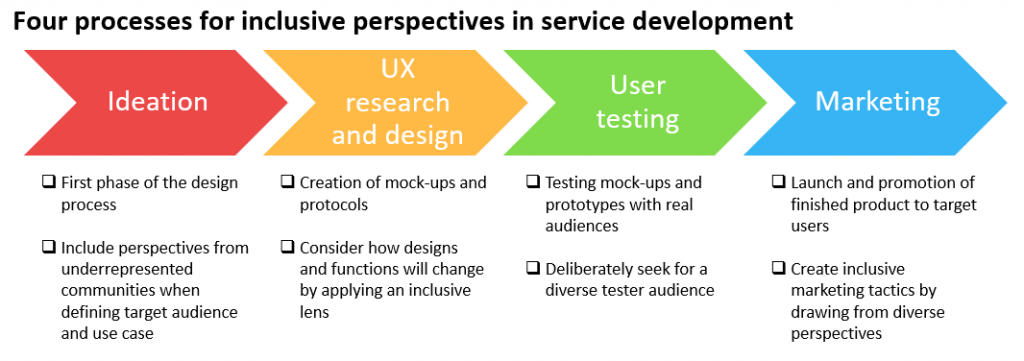Have you ever found using a service in town or online to be stressful, thinking that it wasn’t as it should be, or was difficult to use? For example, simply because you’re a woman, you’re recommended brightly colored items at a store, or you feel inconvenienced by the lack of products designed for left-handed people, or you find it hard to walk around while pushing a stroller due to the many steps on the street.
A diverse range of people live in the world and, because most products and services are designed with the “majority” in mind, such annoyances and inconveniences are inevitable.
At Rakuten, in an effort to resolve such issues, the Corporate Culture Division’s DEIB (Diversity, Equity, Inclusion and Belonging) promotion team plays a central role, working with business divisions and the HR department to promote the “Service Inclusion” initiative.
What is “Service Inclusion”?
Recently, the number of companies incorporating inclusive perspectives into their business has been increasing. One of the best-known examples of such initiatives is “product inclusion” (Jean-Baptiste, 2020), advocated by Annie Jean-Baptiste. Described in detail in Jean-Baptiste’s book Building For Everyone: Expand Your Market With Design Practices From Google’s Product Inclusion Team (John Wiley & Sons, Inc.), product inclusion is a methodology aimed at enabling people to experience products comfortably across all attributes, including age, gender, race, disabilities, and sexual orientation.
As an IT company and platform provider, Rakuten’s business focuses primarily on providing “services” rather than “products.” As such, we have changed this name to “service inclusion” and are building a framework based on Jean-Baptiste’s ideas to bring inclusive perspectives to our services.
Accordingly, in anticipation of the need to widely explain the concept within the company, we have summarized what service inclusion entails as follows.
Service inclusion refers to the range of activities that make services accessible to all users and to incorporating inclusive perspectives into key decision-making processes, from planning to release, for each of the services we provide. Inclusion here means assuming diverse people from all backgrounds as customers and ensuring that no one feels excluded or alienated as a recipient of our services.
In other words, promoting service inclusion could be viewed as providing the means to deliver services to everyone.
Why tackle service inclusion?
Before providing a detalied explaination of the service inclusion framework, let’s look at why Rakuten is embracing this initiative.
According to Jean-Baptiste (2020), there are two reasons why inclusion is important: one is that people matter, and the other is to build momentum over less-inclusive players. She also says that companies that fail to implement inclusive business practices put their bottom line, brand, and reputation at risk.
This suggests that when diversity and its resulting needs are considered and addressed, it is possible to boost and enhance the brand image while avoiding the risk of brand damage resulting from such causes as backlash to marketing that fails to take diverse consumers into account.
Jean-Baptiste also points out that providing inclusive products and services offers the opportunity to tap into trillions of dollars of global spend (Jean-Baptiste, 2020), suggesting that by expanding the scope of services offered to the diversity in the world, companies can expand their business beyond what they could through the conventional majority-only approach.
While it is only natural to want to enjoy these rational business benefits, what is most important to us is that all people, spanning a diverse range of attributes and values, find Rakuten’s services easy to use and want to use them. Under Rakuten Group’s mission of “empowering people and society through innovation,” we believe that striving to realize service inclusion is one approach to achieving our mission.
The four processes required for inclusive perspectives
Let’s now look at the methodology used to promote inclusive product development based on the product inclusion approach advocated by Jean-Baptiste.
She points out the need to incorporate inclusive perspectives in all four processes (Ideation, User experience [UX] research and design, User testing, Marketing) of development (Jean-Baptiste, 2020).

Figure 1: The four processes required for inclusive perspectives in service development. Created by the Rakuten DEIB team based on Jean-Baptiste (2020).
The four processes shown above can be briefly summarized as follows.
- Ideation: Obtaining input from users with diverse perspectives to identify target customers and usage situations.
- User experience (UX) research and design: Considering how to change the service’s design and functionality by developing it for formerly unanticipated customers.
- User testing: Diversifying the backgrounds and attributes of users who participate in user testing to diversify feedback perspectives.
- Marketing: Planning and promoting measures while role-playing with diverse user demographics followed by implementing them.
In recent years, we have had more opportunities to see an increased focus on inclusive perspectives in the marketing process, during which completed services are delivered. An example of this is the diversity of race and body types of the models now seen in advertisements. In reality, there is no way to know the degree to which inclusive perspectives were incorporated during the development stage of the products and services introduced in such advertisements as such efforts are not readily apparent. In fact, when we conducted hearings about Rakuten’s services with each business unit, there were not many cases where the initial three processes mentioned above were consciously put into practice.
It was through our internal hearings that we once again realized that if we really wanted a diverse range of users to find all of our services easy to use and want to use them, it was important to sincerely consider incorporating the input of people with diverse attributes and values from the initial ideation stage, during which we determine the kind of service it is we want to create and for whom we aim to serve.
How to incorporate the opinions of diverse people
How do we go about incorporating the views of diverse people? When it comes to implementing service inclusion, this is a very important topic.
It appears that the series of DE&I-related HR policies that were discussed in Japanese companies in the past, starting with the promotion of diversity, did not lead to any anticipated contributions to business. Thanks to Jean-Baptiste’s suggestion, we were able to realize how important it is to work backward from the goal of contributing to business to the the aforementioned promotion of diversity. In other words, in order for all customers to feel comfortable using our services, it is important to bring each team member’s diverse perspective to the discussion regarding the growth and development of the service.
Bringing these diverse perspectives to the discussion through the application of an “inclusive lens” (Jean-Baptiste, 2020) was something Jean-Baptiste emphasized as a key factor.
Rakuten’s services are available worldwide and even in Japan we have colleagues from diverse cultural backgrounds. In addition, there is the LGBTQ+ community, people with disabilities, people raising children or caring for family members, and others with diverse backgrounds who desire diverse working styles. In practice, however, it is difficult to ensure that every team has a diverse range of members that align with the targeted users of the service they create.
But even when that is the case, through such means as seeking out feedback from target customers, or from those within the company within the same target audience, it is possible to find numerous ways to input the thoughts, behavioral styles, and true needs of these target users. Balancing the attributes of the employees within the team is not the only approach.
Another thing that supports our work at Rakuten is our internal Employee Resource Groups (ERGs). Each ERG, which comprises people who share the same characteristics and values within the organization and the people who support them, works to solve its awareness problems and issues. There are a variety of ERGs within Rakuten, including those for people with disabilities, the LGBTQ+ community, and gender, and collaborating with them is essential in promoting service inclusion.
According to Jean-Baptiste, designing for a minority also benefits the majority. For example, the closed-caption function used by people with hearing disabilities is also used by people for whom the captioned language is their second language, and sloped curbs that eliminate steps for people with limited mobility are also convenient for people using strollers. As a result, these solutions often provide a wide range of benefits without detriment to anyone else (Jean-Baptiste, 2020).
For service inclusion to succeed, linking corporate growth with the provision of services that don’t make diverse customers feel left out should be deemed an indispensable perspective, one viewed by everyone involved as a personal matter.
In the next article, we will go into more detail about how we are promoting service inclusion.
Work cited:
Jean-Baptiste, A. (2020). Building For Everyone: Expand Your Market With Design Practices From Google’s Product Inclusion Team. NJ: John Wiley & Sons, Inc.
Link:
Press Release – Rakuten Launches “Service Inclusion” Initiative to Develop Services Embracing Diversity, Equity and Inclusion

